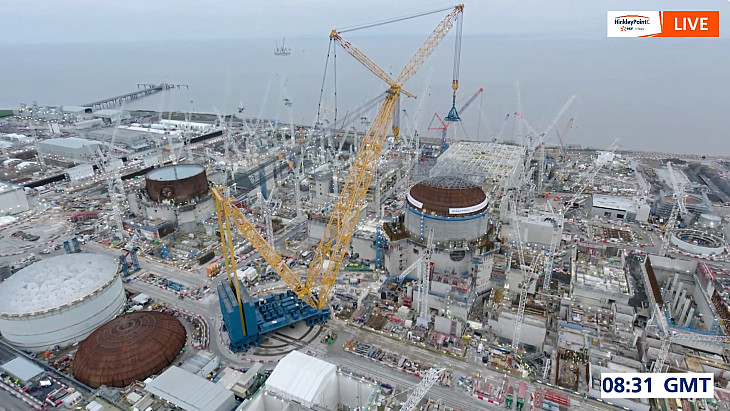Construction of Hinkley Point C - composed of two EPR reactors of 1630 MWe each - began in December 2018, with unit 1 of the plant originally scheduled to start up by the end of 2025, before the revision to 2027 in May 2022. The news of the further schedule change comes just weeks after the landmark moment of the dome being installed on the first unit at the plant.
In a statement released on Tuesday evening, EDF said a review of the project had been finalised and the aim now was to bring unit 1 into service "around the end of the decade". It gave three scenarios, with the first being unit 1 operational in 2029, based on a target productivity for the electromechanical work. The second scenario - the "base case" - assumes some risks in the electromechanical work and the testing schedule, and 2030 operation. The third scenario is for a further 12 month delay to 2031.
The French-state owned nuclear giant said it now estimated the likely cost at between GBP31 billion and GBP34 billion, at 2015 prices, with a further GBP1 billion cost for the third scenario.
In a message to staff at the site, Stuart Crooks, managing director of Hinkley Point C, said that the COVID-19 pandemic had caused a 15 month delay to the project, adding: "Going first to restart the nuclear construction industry in Britain after a 20-year pause has been hard. Relearning nuclear skills, creating a new supply chain and training a workforce has been an immense task which others will benefit from for decades to come. Like other infrastructure projects we have found civil construction slower than we hoped and faced inflation, labour and material shortages on top of COVID and Brexit disruption.
"The good news is that much of that pioneering work to rebuild our industry is done. Once we learn how, we see performance improve by 20-30% when we repeat work on our identical unit two. Innovation is making a difference too. For example, new welding techniques mean we can now weld a metre on our steel pools in one hour instead of four. Building and repeating an identical design is the key to success - the evidence is clear."
He said that 70% of equipment had now been delivered for unit 1, and "many risks are behind us, like the unique British instrument and control system which has been designed and manufactured, with testing under way". He added: "We had to substantially adapt the EPR design to satisfy British regulations, requiring 7000 changes, adding 35% more steel and 25% more concrete. This adaptation and approval process is the same for other developers bringing new designs into Britain. Now the design of our UK plant is complete in detail meaning contractors have certainty over exactly what is needed to build the plant."
Crooks also said that "British consumers or taxpayers won't pay a penny, with the costs met entirely by shareholders".
Tom Greatrex, chief executive of the UK's Nuclear Industry Association, said: "The more nuclear stations we build the quicker and cheaper it will become, so instead of building one plant at a time with long gaps in between projects, a programmatic approach, as outlined in the government’s Nuclear Roadmap, is vital to ensure we build expertise, maintain workforce capability and increase efficiency. Hinkley Point C is the most significant green energy project ever in the UK and represents the revival of an industry after a generation of not building any new plants. It has revitalised the supply chain, creating thousands of skilled jobs in the process and will provide vital learnings for the rest of the industry."
The EDF announcement on Hinkley Point C's schedule came on the same day the UK government announced it was providing a further GBP1.3 billion to the Sizewell C project in eastern England, to allow construction work to continue pending a final investment decision on the plant which is due to be a replica of Hinkley Point C.






_91467.jpg)
_47120.jpg)
_16439.jpg)





